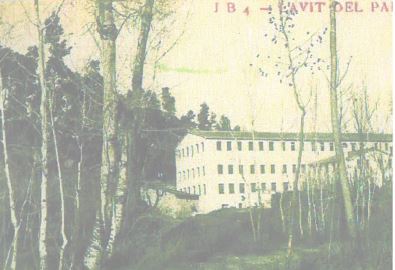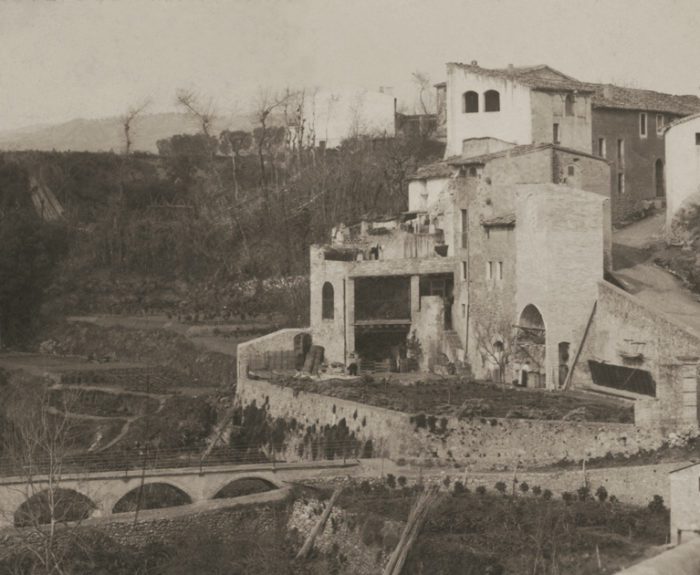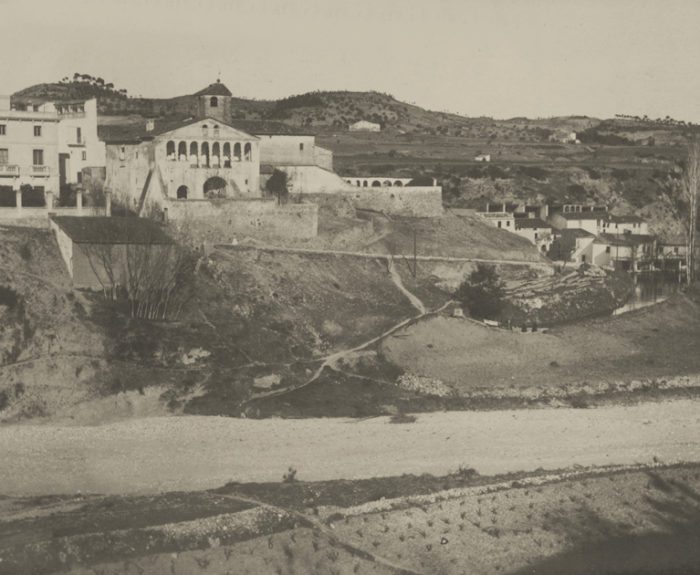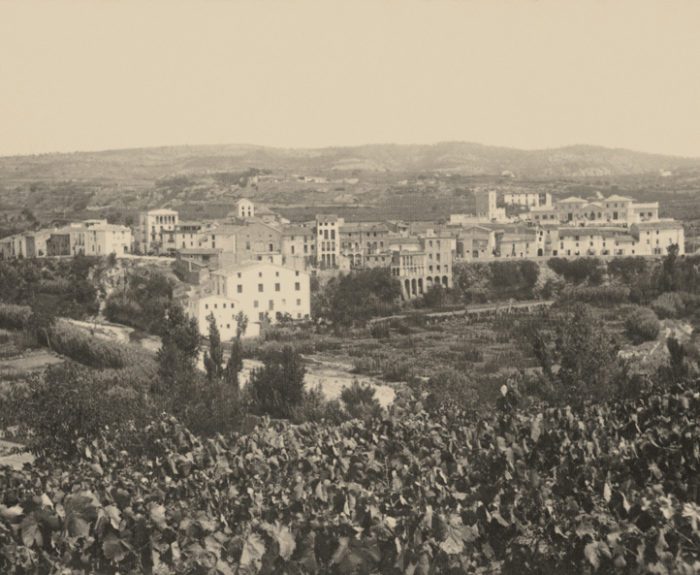History of Can Rocabruna
Discover the history of Can Rocabruna








History
Masia Ribalta dates back to medieval times. This architectural ensemble has been part of the Alt Penedès region, specifically in the area currently known as Torrelavit.
The Masia Ribalta consists of a main structure with a rectangular floor plan, including a ground floor and an upper floor with a symmetrical composition of openings in the main façade. This building stands out for its porticoed gallery with four arcades dating from approximately the 14th century. Inside the complex is the Chapel of Sant Joan de Ribalta, mentioned in documents dating from 1390.
In addition, the heraldic coats of arms present on the farmhouse and its chapel link the property to the important families of the medieval Catalan nobility, reflecting their significant social and economic role during those times.
The Mas is mentioned in texts as early as 999, but it was during the 14th century that the Ribalta family established themselves as the feudal lords of the area, noted for their agricultural activities and their water mill that used the waters of the river Bitlles. Subsequently, the property passed into the hands of the Avinyó family in the 14th century due to marriages and inheritances.
Medieval Origins
- Foundation and First Mentions:
- The territory of Masia Ribalta is located in what was originally known as Terrassola and Lavit. “Lavit” in historical documents appears as “ipsa Vide” (10th century), suggesting its origin in a Latin word that could mean “vinya”.
- Mas Ribalta de Lavit has been mentioned since 999, when Ermenard donated his property, including land, vineyards and mills, to the monastery of Sant Cugat del Vallès.
- Property Developments:
- Throughout the 11th century and beyond, the region experienced several donations and transactions involving mills and land, indicating the agricultural and economic importance of the area.
- During the 12th century, the Ribalta family established themselves as the feudal lords of the mas and the castle of Lavit. Documents from 1189 already mention Berenguer de Ribalta as the lord of these territories.
- Transition to the Avinyó Family:
- Around 1350, the management of Mas Ribalta and its mill was taken over by Huguet d’Avinyó due to a donation from the Ribalta family through the lords of Gunyoles, demonstrating the complex relationships of marriage and inheritance of the Catalan nobility of the time.
- The Avinyó, a family that lived in the Penedès from the 11th century, would continue to control the property until at least the 15th century, when documentation becomes scarce.
- Architectural and Social Importance:
- The farmhouse and the adjoining chapel, Sant Joan de Ribalta, are outstanding examples of medieval Catalan architecture, with distinctive elements such as segmental arches and a chapel dating from 1390.
- The chapel played a significant role in the religious and social life of the area, being mentioned in several wills and religious documents throughout the 14th and 15th centuries.
Historical Context
The Penedès region, where Masia Ribalta is located, has been an area of considerable human activity since prehistoric times, as evidenced by finds of Palaeolithic industry. This background further enriches the understanding of the origins and evolution of Masia Ribalta, reflecting a long history of human occupation and agricultural use that defined the medieval economy of Catalonia.
These elements show us not only the architectural and heritage richness of Masia Ribalta, but also its integral role in the history and economic development of the Penedès region.
Chronology of the Masia Ribalta and its Surroundings
- 999 – Ermenard donates properties including land, vineyards, houses, corrals and mills in the area of the castle of “ipsa Vide” to the monastery of Sant Cugat del Vallès.
- 1093 – The monastery of Sant Cugat establishes Guillem Arbert i Mir and his brothers in one of the donated mills, which could be that of Ribalta.
- 1189 – Berenguer de Ribalta is mentioned in the will of the Castilian Guillem de Sant Marti as lord of the castle of Lavit, confirming the presence and control of the Ribalta family over this area.
- 1299 – Documentation of Pere de Ribalta, a relative of Berenguer, as lord of the place of Ribalta; his widow, Saurina, writes her will in 1327.
- 1350 – Huguet d’Avinyó becomes the feudal lord and administrator of the Ribalta farmhouse and its mill by donation from the Ribalta family through the lords of Gunyoles.
- 1390 – Mention of the Ribalta farmhouse chapel in a testamentary document, indicating its religious and social importance in the region.
- 1396 – Constança, wife of Huguet d’Avinyó, and Huguet himself draw up their wills, showing the transition of control of the mas and the chapel to their descendants.
- 1399 – On the death of Dalmau d’Avinyó, control of the mas passed to his brother Berenguer.
- 14th-15th century – The Avinyó family maintains control of the Ribalta farmhouse, although over time their direct influence is diluted and the property begins to change hands.
- 1442 – The rights to the Ribalta farmhouse are still held by Berenguer d’Avinyó’s widow, Iolanda, although the sale of many of these rights to third parties begins, including the preveres of the church of Santa Maria de Vilafranca.
- 1455 – The king signs a safeguard for Iolanda d’Avinyó, confirming her status and legal protection as mistress of the Ribalta house. This action marks an end to clear documentation of direct ownership by the Avinyó family.
- 16th century – Documents indicate that the Ribalta mill is still in operation, now under the management of Antoni Mata, reflecting the continuity of economic activity in the mas.
- 17th-18th century – The Torrelavit area and its properties, including Masia Ribalta, undergo a series of changes in ownership and agrarian structure, common in Catalonia due to economic crises and agrarian reforms.
- 19th century – The Penedès region begins to gain recognition for its wine production, which probably affected the activities at Masia Ribalta and its surrounding lands, adapting to market demands.
- 20th Century – The farmhouse is affected by the Spanish Civil War (1936-1939) like many properties in the region, suffering damage and possible looting, although specific details about Masia Ribalta during this period are not clearly documented.
- Late 20th Century – Early 21st Century – Restoration and renovation of Masia Ribalta to adapt to new uses such as cava production, while maintaining the structure and historical features of the property.
- Present day – Masia Ribalta operates as an accommodation establishment (Can Rocabruna), offering an experience that combines historical richness with modern comfort, highlighting its medieval architecture and significant history.
Importance
Each of these points marks a significant period in the evolution of the Masia Ribalta, from being part of a monastic gift to becoming an important manorial property in the feudal structure of Catalonia. This chronology reflects not only the changes in land ownership and management, but also the social, economic, and religious practices of medieval times in the Penedès.
The origin of Torrelavit
Torrelavit arose from the merger of two localities, Terrassola and Lavit. In 1920, these two places decided to unite under the new name of Torre-Lavit.
The Lavit area was first mentioned in the 10th century as a division of the border castle of Subirats. However, it was not until the second half of the 10th century that Lavit was consolidated as a clearly defined territory, with vineyards and cereal crops, orchards and flour mills.
Terrassola already existed in the 10th century as a demarcation belonging to the border castle of Mediona. The first record of this place dates back to 990, documenting the sale of both cultivated and barren land with a house. However, Terrassola began to appear more frequently in documents from the 11th century onwards, and by the 12th century, various records confirm that it was well cultivated and populated.
Final Reflection
The history of Masia Ribalta is a testimony to the social, economic and political evolution of Catalonia over the centuries. From its origin as a feudal mas to its conversion into a modern hotel, each stage of its history reflects wider changes within the Penedès region and Catalonia in general. This farmhouse has not only witnessed history, but has been an active participant in the economic and social life of its surroundings.
Therefore, it could be said that the Masia Ribalta clearly existed as a stately and agricultural establishment since at least the 14th century, consolidating its status throughout this century with the transition of ownership from the Ribalta family to the Avinyó family. This change not only reflects the continuity of the use and importance of the farmhouse, but also its evolution in the social and economic structure of the Penedès region during the Middle Ages.
Given that the documentation explicitly mentions the Ribalta family and their link to the Masia Ribalta in the 14th century, and considering that Huguet d’Avinyó became the administrator of the mas and its mill around 1350, we can affirm that the Masia Ribalta already existed as a significant entity before that date.








Plan an unforgettable experience at Can Rocabruna today.
We can help you tailor your stay and experience to your budget.
Book your stay now
- +34 93 125 0 125

